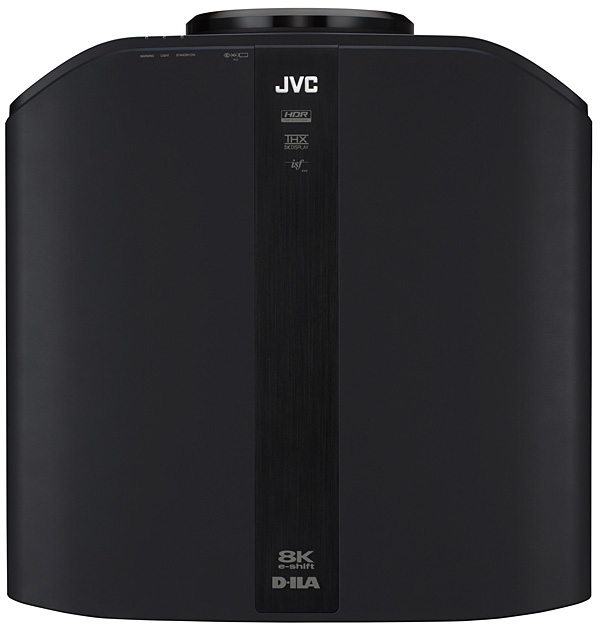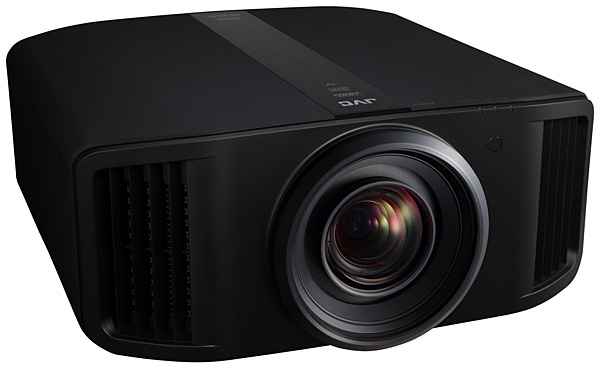JVC DLA-NX9 D-ILA Projector Review Page 2
After putting 200-plus hours on the projector's bulb, my base calibration had drifted enough that a re-do was required. The overall Delta Es for both grayscale/gamma and color were dialed in to less than 2, with the majority of measurements coming in under 1. (Delta E, or dE, is a figure of merit indicating how close the color comes to the standards, either D65 for the white point or the color coordinates for each of the primary and secondary colors that define the color gamut under test. Values below 3 are generally unnoticeable.)
 For HDR calibration, I started out with JVC's HDR picture preset. Two color profiles are available for HDR material: BT2020 and HDR. The BT2020 profile engages a color filter in the light path to increase the available gamut and gives the NX9 full coverage of the P3 color gamut within the 2020 color space (my measurements indicated that coverage was about 99.8 percent). Since I was using the High lamp mode for HDR viewing, this resulted in only about a 5-8 percent loss in overall light output—a trivial amount given the substantial increase in color fidelity. When I tested JVC's RS4500, it lost approximately 40 percent of its light output with the color filter engaged, so this is a huge improvement. The HDR color profile foregoes the filter and provides anywhere from about 88-90 percent of P3 coverage within the 2020 color space. This color mode still looked quite good, though I did note minor clipping and oversaturation with some content as the projector ran out of range. My advice is to use the BT2020 color profile unless you are seriously pressed for light output.
For HDR calibration, I started out with JVC's HDR picture preset. Two color profiles are available for HDR material: BT2020 and HDR. The BT2020 profile engages a color filter in the light path to increase the available gamut and gives the NX9 full coverage of the P3 color gamut within the 2020 color space (my measurements indicated that coverage was about 99.8 percent). Since I was using the High lamp mode for HDR viewing, this resulted in only about a 5-8 percent loss in overall light output—a trivial amount given the substantial increase in color fidelity. When I tested JVC's RS4500, it lost approximately 40 percent of its light output with the color filter engaged, so this is a huge improvement. The HDR color profile foregoes the filter and provides anywhere from about 88-90 percent of P3 coverage within the 2020 color space. This color mode still looked quite good, though I did note minor clipping and oversaturation with some content as the projector ran out of range. My advice is to use the BT2020 color profile unless you are seriously pressed for light output.
A new HDR-related feature in JVC's 2019 lineup is called Auto Tone Mapping. Previous models used a fixed tone map that offered a "one size fits all" approach with minimal available adjustments. While such an approach is common with projectors, it leads to viewer complaints of HDR pictures being "too dark" or "blown out." JVC's new system is very similar to the auto tone mapping feature I discussed in my review of Panasonic's DP-UB820 Blu-ray player (October/November 2018) Basically, the projector adjusts the tone map automatically based on the incoming metadata and focuses on the MaxCLL (maximum level of a single pixel) and MaxFALL (maximum frame average light level).
This provides a more "plug and play" experience when watching HDR content that I found to work well. JVC even includes a slider to adjust image brightness balance for those wanting a slightly brighter or dimmer image based on the viewing environment. For situations where the HDR content lacks metadata, the JVC falls back to a tone map optimized for around 1,000 nits and also provides picture adjustments for tuning. Perhaps the biggest selling point for JVC projectors over the years has been their contrast performance. JVC's black levels extend far lower than the competition, giving them a reputation for almost OLED-like image quality. That said, the company's first 4K projector, the DLA-RS4500, actually represented a big step backward when it came to native contrast. The 3rd generation D-ILA 4K imaging chip featured in the NX9 is a clear step up from the RS4500 in this regard. During my testing, worst-case native contrast fell in the 27,000 to 30,000:1 range—nearly three times what I measured with the RS4500. While I would have preferred to see native contrast numbers measuring closer to previous JVC e-Shift offerings, which started near the 40,000:1 range, this was still a big improvement and was definitely visible when viewing regular programs. While the NX9's native contrast is lower than previous JVC models, it's still substantially higher than the competition, even when those projectors operate in dynamic mode. Closing down the apertures increased native contrast to around 52,000:1, but also resulted in an objectionable decrease in overall light output.

JVC's dynamic contrast modes turned out to be a mixed bag. Measured peak contrast increased significantly with the dynamic iris engaged, hitting 232,500:1 with the manual aperture fully open, and around 52,000:1 with it fully closed. The Auto 2 mode (Auto 1 is too aggressive, so I recommend avoiding it) did deliver deep blacks, but also had a few issues that cropped up on rare occasions. The first was an artifact that made whites look yellow for a split-second. This was most obvious when a small white object appeared on a black background, but I also saw it a few times during normal viewing. It seemed to be more of an issue with the manual aperture fully open, or almost fully open, since that state creates the biggest swing for the dynamic system in terms of both iris position and output level manipulation. (JVC says it is aware of this bug and is looking into it.)
Performance
Since I'm a home cinema aficionado, movie viewing is always my first priority. If you are a sports fan, the JVC does do a fantastic job with motion and color, but as with any projector, you have to take into account how much light output you need based on screen size and viewing conditions. While the JVC is a bright projector overall, for HDR viewing it works best in light-controlled viewing environments with screens no larger than around 11 feet wide. The NX9 delivered a calibrated light level of 16 footlamberts (ft-L) on my 11-foot-wide scope screen (Stewart Studiotek 100 material) for SDR and a peak white level of about 28 ft-L for HDR, which is slightly higher than what I measured with the similarly rated 2,200-lumen Sony VPL- VW995ES. It's also in line with the previous JVC e-Shift models I've tested.
The NX9 really delivered on movies, its combination of reference-quality optics and high native contrast delivering a picture that was truly second to none. Like the RS4500, it sailed through even the most demanding test patterns I threw at it. I saw no ringing or banding artifacts, and image uniformity was impressive. Unfortunately, my review sample suffered from the common JVC "bright corner" issue with a full black field. This rarely manifested during normal viewing but was more obvious than I prefer with a full black screen.
JVC's new auto tone mapping did a commendable job on movies that I typically use for HDR torture tests such as the Ultra HD Blu-ray release of The Meg. When viewing this disc, I'm accustomed to seeing clipping and blown-out highlights, but JVC's projector required zero adjustment to make the image look gorgeous. In fact, the NX9 handled this title better than some of the best outboard video processors I've tested!

Lucy and Blade Runner 2049 are two other titles that I use during my evaluations. Blade Runner is a particularly demanding disc, one that tends to look far too dark on most HDR-capable projectors. The JVC's auto tone mapping was a step in the right direction, although the image was still a touch darker than it needed to be. Watching key scenes from Blade Runner on my LG OLED TV, there was a subjectively brighter balance to the image, despite the movie having limited overall dynamic range (peak brightness levels max out around 200 nits). Lucy is a showcase for color, picture contrast, and fine detail. Viewed on the NX9, the picture quality delivered by this disc was staggeringly good.
Other Ultra HD Blu-ray disc releases that impressed me during my NX9 evaluation included Spiderman: Into the Spiderverse and Aquaman. The animation in Spiderman is pure eye candy, and the JVC's high-contrast capability in particular made this movie a visual stunner from beginning to end. Aquaman, meanwhile, looked so sharp, detailed, and artifact-free that it was almost distracting!
As Good as It Gets
Getting to review the DLA-NX9 was an absolute thrill. The performance of JVC's new 4K LCOS panels is nothing short of breathtaking, and I am delighted to see the company introduce the same high-performance lens used in its $29,995 DLA-RS4500 at a lower price point. Although the NX9 represents a hefty price increase over the next step down in the lineup, the $8,000 DLA-NX7, that model lacks the NX9's lens and 8K e-Shift feature. The NX9's reference-level video performance and exceptional usability make it one of the best home theater projectors I've tested.




























































